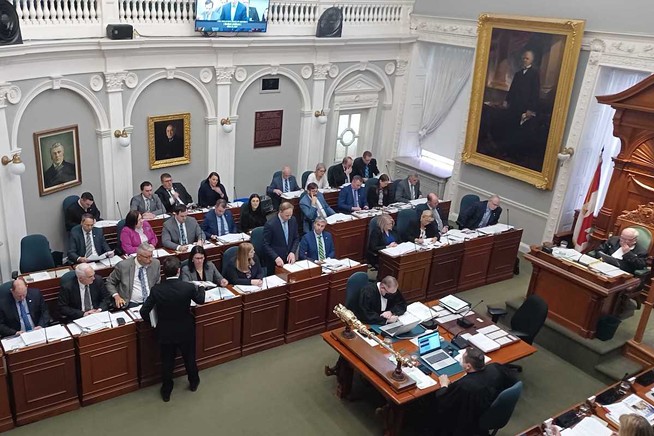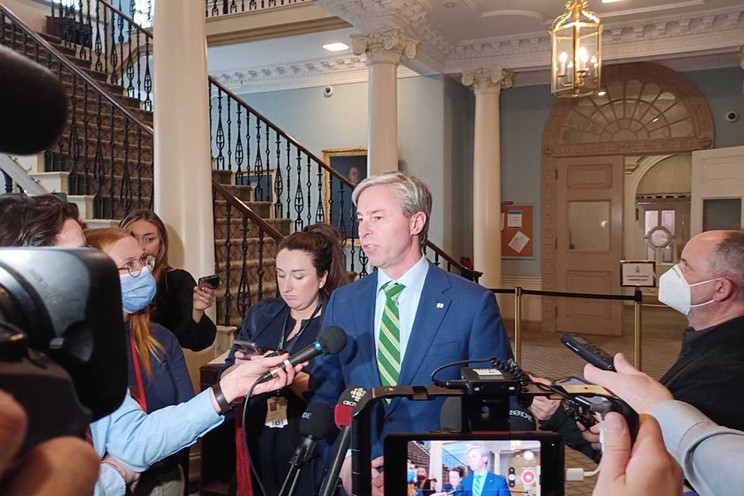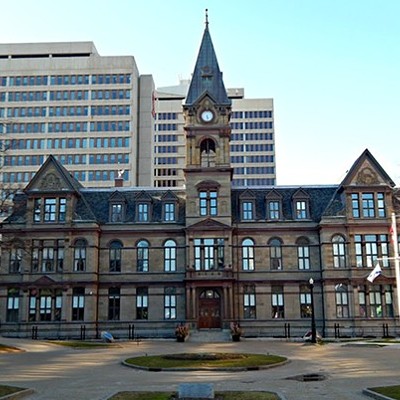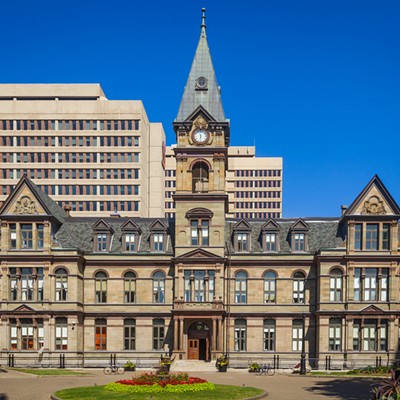Politicians don’t like to say what they mean anymore. It’s an annoying habit they’ve picked up over the years, but it’s one that helps them avoid accountability. Which, in turn, increases the odds they can screw up in office and still get re-elected.
Being able to deflect questions is an important skill where avoiding accountability is concerned. One of a politician’s favourite ways of answering a question without actually giving an answer is to use a folksy turn of phrase that sounds like it means something. In Atlantic Canada, due to the proximity to the Atlantic Ocean and the whole maritime culture thing, ship and boat metaphors are common.
Premier Tim Houston used one Thursday, in the press scrum after his government introduced the province’s 2023-24 budget. “Nova Scotians are reasonable people. They know that this ship was going the wrong way. It's a big ship, we're slowing it down, we're turning around,” he said of how this budget addresses Nova Scotia’s financial picture.
One of the unfortunate things for politicians in Atlantic Canada, given that maritime culture thing, is that sometimes people who understand a lot about ship driving end up as journalists. One of them may have even been on the HMCS Preserver in 2011 when slowing down and turning didn’t prevent the crash into Irving’s drydock. I am, apparently, the Forrest Gump of naval metaphors.
How the Preserver crashed can helpfully explain how Houston going full astern and hard to port may be putting Nova Scotia in far more danger.

The ocean is a really big place and, relative to the ocean, ships are really, really small. But despite all that space, and all the advanced safety technology available, many ships end up hitting each other. That’s why anyone who stands watch on a ship professionally has to undergo hours upon hours of training. There’s a whole school of risk management, called bridge resource management, dedicated to helping watchkeepers understand the risks of driving a ship.
When the Preserver crashed, she was heading from the Bedford Basin out towards the Atlantic Ocean and had to pass under the MacKay Bridge. That part of the harbour is called The Narrows. In very simple terms, on good days it’s fine, and on bad days it’s like trying to drive a big car into a small tunnel, on a road that’s moving on a very windy day, and there’s traffic. Currents add to the complexity.
Because a lot of water funnels through a narrows bit of real estate, the currents start affecting ships long before it seems like they should, often in ways that are invisible. On that day in 2011, the Preserver needed to correct its course roughly half an hour before the impact, but we had yet to realize we were in danger. About 15 minutes before impact, we tried to slow down and turn away. We had already committed to the crash 30 minutes before the impact, but we didn’t know; we hadn’t paid enough attention to the currents.
Houston’s government is similarly ignoring dangerous currents. The currents in the political world are the people who work with the province’s most downtrodden and who come to Province House to try and advocate on the downtrodden’s behalf. This year, like most years, they were ignored.
On Thursday, Houston told gathered reporters that his government prefers a “targeted approach” to relieving poverty. These targeted approaches include things like $8 million to the Nova Scotia child benefit program. Most of the people who are on income assistance in the province are single people with no dependents, which means this support does not help them. The second-largest demographic on income assistance is single-parent families. So even though increasing income assistance rates would help more people faster, this government chose a less efficient, less helpful “targeted approach.”
Alec Stratford, executive director of the Nova Scotia College of Social Workers, told gathered reporters that the targeted approach isn’t good because it stigmatizes people and acts as a barrier to access. In the business world, this phenomenon is called breakage, which is defined by Forbes as “an accounting term that identifies revenue recognized from services that are paid for but not used.” Just in case you’re wondering why some people think running a government like a business is a fundamentally bad idea.
Anyway, Stratford finished his scrum by saying “the targeted approach has been done by every government, and it does not substantially meet needs, particularly with the cost of living going up. With the lack of housing, with the lack of basic needs being able to be met, the targeted approach does not come nearly close enough to what we need to see at this point in time.”
He’s right, and we all know he’s right—it’s in headlines every day. People dying in ERs. More and more people ending up without a home. Halifax, the capital city of Nova Scotia, is doing contingency planning for the immediate future that includes refugee camps. For us, to be clear, not refugees. I wonder what they’ll be called? Houston Hotels? Timmy Tents? An abject failure of leadership?
We have already crashed. This attempt to steer us out of danger is only going to change the angle of impact. This budget is angling to make a bad crash a lot worse.

One of the lessons of bridge resource management is to stay ahead of the ship. Learn everything you can about every potential hazard to prevent being surprised by danger in the future. In technical jargon, the Navy calls this the “recognized maritime picture.”
This government is not doing the work to stay ahead of danger. This budget makes some huge assumptions about the future of this province by dumping tons of money into expanding failing infrastructure, or trying to inadequately shore up failing institutions.
Part of budget day at Province House is a technical briefing, where the provincial government’s accounting experts are made available to journalists to answer all of the boring budgetary questions that give us the background we need to write smart money words good.
In that briefing, provincial bean counters were asked if the rise in the federal carbon tax would impact Nova Scotians’ driving behaviour. They said no because we, as Nova Scotians, can’t or won’t give up our cars.
Then they did a little shrug.
The answer is can’t, by the way.
A study done by a ridesharing app found that while 83% of us own a car, we don’t use it 95% of the time. Even knowing that a ridesharing app is a source of that information, most of us recognize our car habits in those numbers. Why would otherwise rational people spend thousands of dollars of increasingly tight household budgets on a giant planet-killing, money-sinking, depreciating asset if not out of necessity?
Houston has gone out of his way to criticize the federal carbon tax. The best way for him to ensure we don’t get hit with the tax is to get us out of cars. His government has invested $15 million in transit funding to get us out of cars and $41.4 million in “Climate Change Plan actions.”
Here’s his government celebrating the decision to spend over $500 million to continue entrenching car dependency in Nova Scotia.
Capital Plan 2023-24 invests $498.5 million in projects outlined in the Five-Year Highway Improvement Plan, including $60 million more than last year for secondary highways and $15 million more for gravel roads.
— Department of Public Works (@NS_PublicWorks) March 13, 2023
For more information, visit: https://t.co/p5HPCjklJH pic.twitter.com/GEnmQxzLTz
For a man who says he hates the carbon tax, he sure is squandering a lot of our money into making sure we keep paying it.
One of the other things that signals danger ahead is the conversation about inflation, housing and the cost of living.
It starts like this: A politician, Houston in this case, says something like “let's not lose sight of all the incredible good things that are happening in this province. There's a lot of good happening as promised. And I think the fact that the budget is now up to $14 billion in spending is indicative of the growth of this province. And that's a good thing.”
Growth! Growth is good! A rising tide lifts all boats and all that. Where does Nova Scotia’s growth come from? Well, 17% of Nova Scotia’s economy is generated from real estate. Just shy of one-fifth of our economy depends on housing becoming more expensive in order to grow. Cool.
The good news is that government programs and spending for us are tied to CPI, the consumer price index. Which does have a line that includes shelter. But how is that calculated? Is that important?
A very simple version of some very difficult math is this, as explained by Kareem Kudus, former Bay Street interest rate strategist turned research analyst over at Generation Squeeze: The spike in home prices takes a few years to affect the consumer price index. Statistics Canada calculates shelter costs that way on purpose because they don’t consider a home a consumer product, and instead treat it like an asset. Here's a typical bit of analysis from StatsCan:
Shelter costs rose at a slower pace year-over-year for the third consecutive month, rising 6.1% in February, after an increase of 6.6% in January. The homeowners’ replacement cost index, which is related to the price of new homes, slowed on a year-over-year basis in February (+3.3%) compared with January (+4.3%). Other owned accommodation expenses (+0.2%), which includes commissions on the sale of real estate, also decelerated in February. These movements reflect a general cooling of the housing market.
Conversely, the mortgage interest cost index increased at a faster rate year over year in February (+23.9%) compared with January (+21.2%), the fastest pace since July 1982. The increase occurred amid a higher interest rate environment.
How rent is calculated in shelter costs is explained by the extremely dense formulas on this website. Those formulas are designed to be good in their intended use—the calculation of the consumer price index—but are limited in everything else. Because these formulas are designed to make solid national predictions on a limited supply of data. By design, it is prone to giving a misleading impression that a local market is more stable than it really is.
Hidden in that math is where Houston’s claim that growth is good simply falls apart. Just over one-third (35%) of all properties in Nova Scotia are income properties. If that’s abnormally high in Nova Scotia because of landlord-friendly policies that encourage massive rent increases, that likely won’t be captured in CPI. But any policy for Nova Scotians based on CPI won’t be high enough for the actual shelter costs we have to pay.
The relief in the budget for renters is $21.6 million to create 1,000 new rent supplements for a total of 8,000. A third of Nova Scotia’s one million people are estimated to be renters, and we’re going to give $21.6 million in public money to 8,000 people’s landlords in a housing crisis.
This will be good for the economy and for growth. But for renters?
And this is all without even mentioning the health-care spending, which for a budget titled “MORE HEALTHCARE, FASTER” sure is underwhelming. A lot of the health-care spending is on one-time retention bonuses, which the government seems to hope will keep people working in Nova Scotia, without really saying why.
Because for health-care workers (like most workers) a lack of money is only half of the issue. The other half of the issue is poor working conditions. The draw of being a travel nurse (which is one of the things attracting nurses out of Nova Scotia’s health-care system) is the higher pay and the better work-life balance. This budget only temporarily helps the money side of things. Since premier Houston and finance minister Allan MacMaster answered questions about strengthening labour regulations by pointing at their retention spending, it’s probably safe to assume they aren’t going to legislate better working conditions.
But without better working conditions, workers will keep leaving, and industry will continue to suffer. There are labour shortages in construction that they can’t seem to fill. But the construction industry is specifically exempt from traditional overtime rules. Instead, construction workers have to work 110 hours to get overtime and can be terminated without notice. That is a special labour legislation carve-out shaped like a giant middle finger to the workers. Wonder why it’s so hard to attract more of them to Nova Scotia?
And while it is doubtless true that this one-time increase in spending will stem or slow the attrition of nurses somewhat, that will not be a long-term fix without addressing the rest of the workforce's concerns. And addressing the workforce’s concerns is not something this government seems in any way interested in fixing.
And that’s the real issue with this budget. All of the spending announced, no matter what the government calls it, isn’t enough. Or it might be enough if there was any indication that the long-term future of Nova Scotia was considered in any way, shape or form in the making of this budget. Because a lot of the things being billed as positives in this budget have some pretty major caveats.
The health-care spending on people has so far been in the form of one-time spending: things like retention bonuses. There are a lot of reasons why health-care workers are leaving; those who are leaving due to money will likely stay on for a bit with this new spending. Those who are leaving due to low wages or work-life balance will not stay long-term. So far, Houston’s government has announced no plans to fix either of those last two problems. And as Stratford, the social worker, told reporters, this budget will actively increase the workload of our already overburdened health-care workers.
Houston seems to be banking on the economy growing in order to make life better for everyone. Even though the booming economy of the past 60 years allowed an entire generation of young people (now in their 40s) to miss the tide supposed to lift their boat?
And even then, that’s not too surprising. The GDP has been growing this whole time, and so too have our unhoused populations. What happened to their boats?
But it’s because the problems facing society—and explaining how things became problems and how to fix them—are insanely complex. It’s hard to explain to people that economic growth in real estate only looks good on paper because there are lagging or under-reported indicators used in the calculations of the consumer price index. We see the economic growth right away, but we only see the cost of that growth years later, if at all.
That’s why politicians use political slogans and nautical metaphors. They use them to sail past complex policy discussions and hide the details with all the bad news far away from sight.
Politicians seem to be banking on us not understanding what goes into turning a ship—hoping we don’t understand when we need to turn out of danger, or why turning won’t get us out of danger. And the really insidious ones try and use metaphors to make us feel good about being driven into the dangerous waters of complexity, with only the simplistic reassurance of a folksy naval metaphor for safety.


















